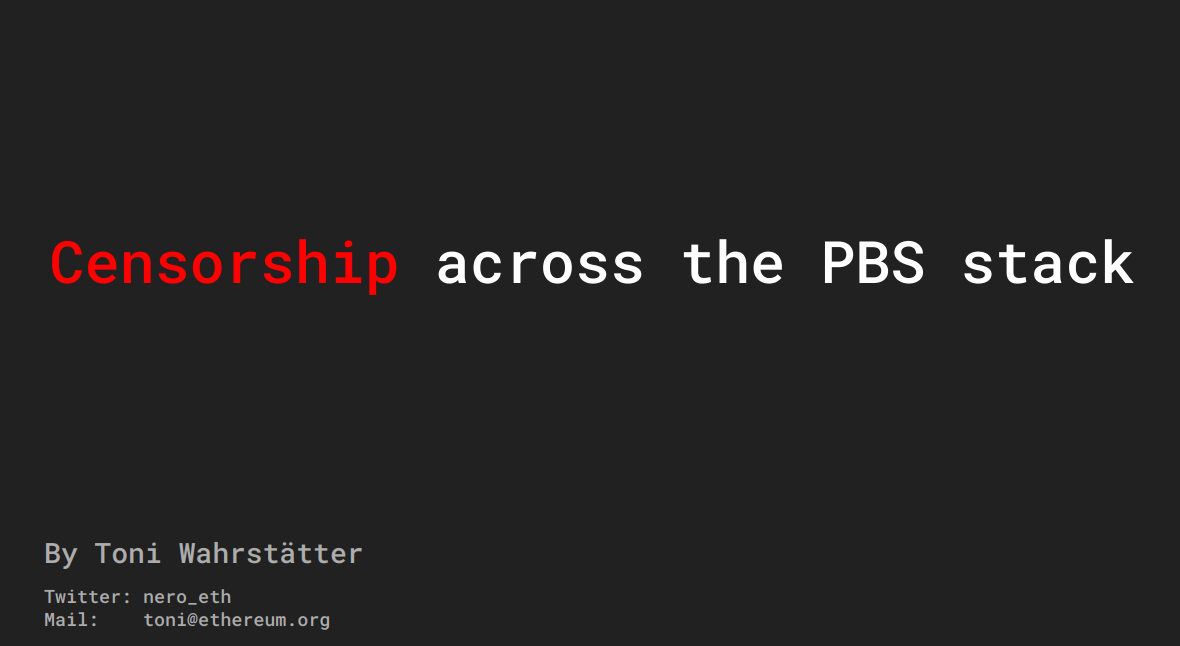Exploring censorship across the PBS Stack - Censorship.wtf
Source : https://www.youtube.com/watch?v=WcJlseuhbX8

What is censorship ?
Censorship is the suppression or restriction of speech, communication, or other information that may be considered objectionable, harmful, sensitive, politically incorrect, or inconvenient by governments, private institutions, or other controlling bodies. - ChatGPT 2023

Toni (the speaker) will compare censorship on Bitcoin VS Ethereum as an example
What to censor ? (2:00)

Censorship in the Ethereum context mainly refers to blocking transactions associated with entities on sanctions lists like OFAC.
The thing is, OFAC is not the only sanctions list. Other countries have their own lists of prohibited entities.
OFAC's list is the most dominant because it was the first to target crypto addresses, like some Bitcoin and Ethereum (Tornado Cash) addresses. We will focus on OFAC's list in the talk since it has the most real impact currently on Ethereum.
Censorship stats
Methodogy : Binomial distribution (3:10)


It involves using a binomial distribution to calculate the probability that a certain number of blocks proposed by an entity would not contain any OFAC sanctioned content by chance.
The more blocks proposed, the more sure they can be that an entity is censoring if none contain OFAC sanctioned content.
For example, 10 blocks is too small of a sample, but 1000 blocks with no OFAC content indicates likely censorship. 2.18% of blocks since the merge have contained OFAC sanctioned content.
This methodology will now be used to analyze censorship on the current Ethereum network.
Validator censorship (4:50)



About 15% of validator slots are currently produced by entities appearing to censor OFAC transactions.
Tornado.pics shows statistics on validators including/excluding Tornado Cash transactions. Validators with very low OFAC transaction inclusion rates that likely indicate censorship include: Figment, Kraken, Celsius, Stkr, Bitstamp, Kucoin, Bitfinex, Everstake pool, Bitpie and cryptostake.com.
Particularities :
- Figment has only 0.32% OFAC transaction inclusion compared to 1.78% for Lido.
- Kraken appears to have started censoring very recently based on their inclusion statistics.
- Some validators have above 0% inclusion despite appearing to censor, which will be explained later.
Relay censorship (6:50)



Relays gained prominence around the Merge, with Flashbots being the dominant censoring relay initially. Early this year, ~80% of relayed blocks were censored due to Flashbots dominance.
Over time more relays emerged like ultrasound, agnostic, gnosis, istos, blockstart - and the situation improved.
Flashbots, Eden, and Blocknative are censoring relays. Non-censoring relays include ultrasound and blockstart.
Sometimes censoring relays fail to censor sanctioned content, like BlocksRoute recently relayed a sanctioned block. Even non-censoring relays may sometimes relay censored blocks by mistake.
To properly censor, relays need to simulate transactions and check contract state, not just transaction sources.
Builder censorship (9:25)


The builder landscape looks concerning, with ~80% of builders now censoring OFAC transactions.
Even if validators connect to non-censoring relays, the high rate of censoring builders means they still often get censored blocks.
Top censoring builders include Oursync, Beaver Build, Flashbots Builder, 69, and Gambit Labs.
Some started censoring only recently after the Merge. Non-censoring builders like Payload and Moneyfold have high Tornado Cash transaction inclusion rates, around 28-50%.
Censoring builders seem to actively avoid Tornado transactions, while non-censoring ones try to include them.
Feather forking...

The "feather fork" is a mean to censor the network with having less than 50% of the hash rate. This concept was originally proposed for Bitcoin in 2013.
...on Bitcoin (11:00)

It involves a minority hashrate entity like Alice (20%) publicly stating they will not build on blocks with transactions from an entity they want to censor, like Bob. Furthermore, Alice will also reorg out any blocks containing Bob's transactions.
With 20% hashrate, Alice has a 4% chance of producing two consecutive blocks to reorg others. Knowing this, other miners are incentivized to also censor Bob's transactions, to avoid being reorged by Alice.
This allows a minority hashrate entity to essentially censor the whole network.
...on Ethereum ? (13:00)

The feather fork could work on Ethereum if large stakers said they would reorg out OFAC sanctioned content.
Currently 5 entities (Lido, Stakefish, Coinbase, Kraken, Figment) could get over 30% stake. If they publicly said they would reorg out OFAC content, rational validators would likely preemptively censor to avoid being reorged.
But unlike Bitcoin, Ethereum would need 51% stake to win a fork choice.
Harsh censorship via reorging hasn't happened yet on Ethereum, because if it did, social slashing could counter it by taking away stake from attacking entities.

More data and tools available on Tornado.pics and Censorship.pics to analyze censorship.